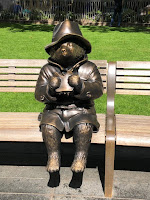Love, Art, Loss: The Wives of Stanley Spencer

Fabulous online talk organised by the Samuel Courtauld Society looking at Stanley Spencer’s two wives Hilda Carline and Patricia Preece. If you follow this blog you’ll know that Spencer is one my favourite artists and I have always been fascinated by his story as well as his art. He married Hilda in 1925 and was devoted to her continuing to write to her after their divorce and even after she had died. However in 1929 he met Patricia Preece in a tea shop in Cookham and became infatuated with her and they married in 1937. This was all despite the fact she was living with her girlfriend, Dorothy Hepworth and continued to do so. The speakers, Amanda Bradley, who has curated the exhibition at the Stanley Spencer Gallery that this talk Is based on, and the author Carolyn Leder, told this story well and it was particularly interesting to hear anecdotes from Leder of people she had interviewed who were part of the tale such as Elsie, Stanley and Hilda’s maid and Daphne Charlton, Spencer’s









